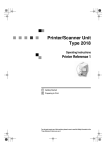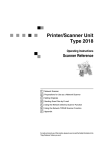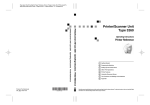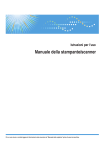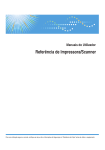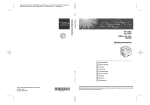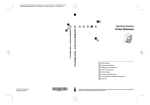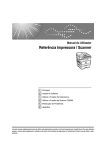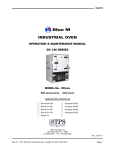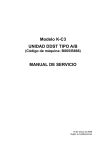Download Ricoh DDST Unit Type B User's Manual
Transcript
DDST Unit Type A / Type B
Operating Instructions
Printer / Scanner Reference
1
Getting Started
2
Installing the Software
3
Using the Printer Function
4
Using the TWAIN Scanner Function
5
Troubleshooting
6
Appendix
Read this manual carefully before you use this machine and keep it handy for future reference. For safe and correct use, be sure to read the
Safety Information in the "Copy Reference" before using the machine.
Introduction
This manual contains detailed instructions and notes on the operation and use of this machine. For your
safety and benefit, read this manual carefully before using the machine. Keep this manual in a handy
place for quick reference.
Important
Contents of this manual are subject to change without prior notice. In no event will the company be liable for direct, indirect, special, incidental, or consequential damages as a result of handling or operating the machine.
Do not copy or print any item for which reproduction is prohibited by law.
Copying or printing the following items is generally prohibited by local law:
bank notes, revenue stamps, bonds, stock certificates, bank drafts, checks, passports, driver's licenses.
The preceding list is meant as a guide only and is not inclusive. We assume no responsibility for its
completeness or accuracy. If you have any questions concerning the legality of copying or printing certain items, consult with your legal advisor.
Caution:
Use of controls or adjustments or performance of procedures other than those specified in this manual
might result in hazardous radiation exposure.
Two kinds of size notation are employed in this manual. With this machine refer to the inch version.
Trademarks
Microsoft®, Windows® and Windows NT® are registered trademarks of Microsoft Corporation in the
United States and/or other countries.
Other product names used herein are for identification purposes only and might be trademarks of their
respective companies. We disclaim any and all rights to those marks.
The proper names of the Windows operating systems are as follows:
•
The product name of Windows® 98 is Microsoft® Windows® 98
•
The product name of Windows® Me is Microsoft® Windows® Millennium Edition (Windows Me)
•
The product name of Windows® 2000 are as follows:
Microsoft® Windows® 2000 Advanced Server
Microsoft® Windows® 2000 Server
Microsoft® Windows® 2000 Professional
•
The product name of Windows® XP are as follows:
Microsoft® Windows® XP Professional
Microsoft® Windows® XP Home Edition
•
The product names of Windows ServerTM 2003 are as follows:
Microsoft® Windows ServerTM 2003 Standard Edition
Microsoft® Windows ServerTM 2003 Enterprise Edition
Microsoft® Windows ServerTM 2003 Web Edition
Notes
Some illustrations in this manual might be slightly different from the machine.
Certain options might not be available in some countries. For details, please contact your local dealer.
Depending on which country you are in, your machine may include certain options as standard. For
details, please contact your local dealer.
Manuals for This Machine
The following manuals describe the operational procedures of this machine. For
particular functions, see the relevant parts of the manual.
Note
❒ Manuals provided are specific to machine type.
❒ Adobe Acrobat Reader is necessary to view the manuals as a PDF file.
❖ General Settings Guide
Provides an overview of the machine and describes System Settings (paper
trays, Key Operator Tools, etc.), and troubleshooting.
❖ Network Guide
Describes procedures for configuring the machine and computers in a network environment.
❖ Copy Reference
Describes operations, functions, and troubleshooting for the machine’s copier
function.
❖ Printer/Scanner Reference (this manual)
Describes system settings, operations, functions, and troubleshooting for the
machine’s printer/scanner function.
i
TABLE OF CONTENTS
Manuals for This Machine ......................................................................................i
How to Read This Manual .....................................................................................1
1. Getting Started
Control Panel..........................................................................................................3
Reading the Display and Using Keys.........................................................................4
Connecting the Machine .......................................................................................5
Requirements.............................................................................................................5
Connecting the machine to the host using a USB cable ............................................5
2. Installing the Software
Auto Run.................................................................................................................7
Installing the Printer Driver...................................................................................8
Installing the TWAIN Driver...................................................................................9
Software Supplied on CD-ROM ..........................................................................10
DDST Driver.............................................................................................................10
DDST TWAIN Driver ................................................................................................10
3. Using the Printer Function
Printer Features Menu .........................................................................................11
Adjusting Printer Features..................................................................................12
Printer Features Parameters...............................................................................13
Paper Input...............................................................................................................13
List/Test Print ...........................................................................................................13
Maintenance.............................................................................................................14
System .....................................................................................................................16
Host Interface...........................................................................................................16
Setting Paper on the Bypass Tray......................................................................17
Setting the paper size ..............................................................................................18
Setting custom size paper........................................................................................19
Setting thick paper or OHP transparencies..............................................................20
Setting envelopes.....................................................................................................21
Setting Up the Printer Driver and Canceling a Print Job .................................23
Windows 98SE / Me - Accessing Printer Properties ................................................23
Windows 2000 / XP and Windows Server 2003 - Accessing Printer Properties ......24
Canceling a Print Job ...............................................................................................25
4. Using the TWAIN Scanner Function
TWAIN Scanner ....................................................................................................27
Preparation for Using the Network TWAIN Scanner.........................................28
TWAIN Scanner Screen...........................................................................................28
Setting Originals ..................................................................................................29
Placing Originals ......................................................................................................29
Scanning Originals ..............................................................................................32
ii
5. Troubleshooting
The Printer Function............................................................................................33
Error & Status Messages on the Display .................................................................33
The Machine Does Not Print ....................................................................................36
Other Printing Problems...........................................................................................38
The Scanner Function .........................................................................................40
When Scanning Is Not Performed as Expected .......................................................40
When an Error Message Appears on the Client Computer......................................41
6. Appendix
The Printer Function............................................................................................43
Collate and Rotating Collate ....................................................................................43
Edge to Edge Printing ..............................................................................................43
The Scanner Function .........................................................................................44
Relationship between Resolution and File Size .......................................................44
Specifications.......................................................................................................45
Printer.......................................................................................................................45
Scanner....................................................................................................................46
INDEX......................................................................................................... 47
iii
iv
How to Read This Manual
Symbols
In this manual, the following symbols are used:
R WARNING:
This symbol indicates a potentially hazardous situation which, if instructions
are not followed, could result in death or serious injury.
R CAUTION:
This symbol indicates a potentially hazardous situation which, if instructions
are not followed, may result in minor or moderate injury, or damage to property.
* The statements above are notes for your safety.
Important
If this instruction is not followed, paper might misfeed, originals might be damaged, or data might be lost. Be sure to read this.
Preparation
This symbol indicates prior knowledge or preparation is required before operation.
Note
This symbol indicates precautions for operation, or actions to take after mal-operation.
Limitation
This symbol indicates numerical limits, functions that cannot be used together,
or conditions in which a particular function cannot be used.
Reference
This symbol indicates a reference.
[
]
Keys and buttons that appear on the computer's display.
[
]
Keys that appear on the machine's display.
{
}
Keys built into the machine's control panel.
{
}
Keys on the computer's keyboard.
1
2
1. Getting Started
Control Panel
1 23
4
7
6
5
User Tools/Counter
8
9
10
ClearModes
Copy
ABC
DEF
GHI
JKL
MNO
PRS
TUV
WXY
Clear/Stop
Scanner
Escape
OK
Start
Printer
Duplex
Original
Text
Combine/
Series
Sort
Lighter
Darker
Photo
OPER
Enter
11 12
1. {Scanner} key
13
14
15
ANX003S
9. Main power indicator and On in-
Press to activate the scanner function.
dicator
2. {Printer} key
The main power indicator lights when
the main power switch is turned on. The
On indicator lights when the operation
switch is turned on.
Press to activate the printer function.
3. Indicators
Displays errors and machine status.
h: Error indicator. See Network Guide
and General Settings Guide.
B: Load Paper indicator. See Copy Reference.
D: Add Toner indicator. See Copy Reference.
4. Display
Displays operation status and messages.
5. Selection keys
Correspond to items on the display. Press
to select the corresponding item.
6. Scroll keys
Press to select an item.
{U}: scroll upward
{T}: scroll downward
{V}: scroll right
{W}: scroll left
10. Operation switch
Press to turn the power on. The On indicator
lights. To turn the power off, press again.
Note
❒ This key is inactivate during printing
or while setting printer defaults.
11. {Online} key
Press to switch the printer between online and offline.
12. Data In indicator
Blinks while the printer is receiving data
from a computer or printing. Lit when
preparing to print.
13. {Escape} key
Press to cancel an operation or return to
the previous display.
7. {User Tools/Counter} key
14. {OK} key
Press to change default or operation parameters according to requirement.
Press to set a selected item or entered numeric value.
8. {Clear/Stop} key
15. Number keys
Clear: clears an entered numeric value.
Press to enter numeric values.
3
Getting Started
Reading the Display and Using Keys
This section explains how to read the display and using the selection key for the
initial display.
1
Note
❒ The copy display is set as the default screen when the machine is turned on.
You can change the settings in [System Settings]. See General Settings Guide.
4
Escape
1
2
OK
3
ANX007S
1. Selection keys
3. {OK} key
Correspond to the function items at the
bottom line on the display.
Example: Basic screen
When the instruction "press [JobReset]"
appears in this manual, press the center
selection key.
Press to set a selected item or entered numeric value.
2. {Escape} key
Press to cancel an operation or return to
the previous display.
4
4. Scroll keys
Press to move the cursor in each direction, step by step.
When the {U}, {T}, {V}, or {W} key appears in this manual, press the scroll key
of the same direction.
Connecting the Machine
Connecting the Machine
Reference
For details about connection using
Ethernet, see "Connecting the Network Cable to the Network", Network Guide.
A Connect the USB 2.0 interface ca-
1
ble to the USB port on the right
side of the machine's back cover.
Requirements
Before using this machine, make sure
all environmental and electrical requirements are met. Connect the machine to the host computer using the
USB port or network interface unit.
Make sure all cables, connectors, and
electrical outlets necessary to attach
the machine to the host computer or
network are close at hand.
Connecting the machine to the
host using a USB cable
You can connect the machine to the host
computer using a USB interface cable.
The USB cable is provided according
to machine model:
• Standard model
The USB cable is provided for this
model.
• Network standard model
The USB cable is not provided for
this model. Purchase a cable that is
suitable for connecting this model
to your computer.
Follow the procedure below to connect the machine to the host computer
using a USB interface cable.
ANX001S
B Connect the other end to the USB
port on the host computer.
The machine and computer are
now connected. The printer driver
and TWAIN driver must be installed next. For details about how
to install the printer driver and
TWAIN driver, see p.8 “Installing
the Printer Driver” and p.9 “Installing the TWAIN Driver”.
Note
❒ If USB 2.0 is used with Windows 98 SE/Me, only a speed
equivalent that of USB 1.1 is
possible.
5
Getting Started
1
6
2. Installing the Software
This manual assumes you are familiar with general Windows procedures and
practices. If you are not, see the operating instructions that come with Windows
for details.
Auto Run
Inserting the CD-ROM into the CDROM drive starts the installer automatically. The installer helps you install the following printer drivers and
software easily.
Note
❒ When “plug and play” starts, click
[Cancel] in [New Hardware Found],
[Device Driver Wizard] or [Found New
Hardware Wizard] dialog box, and
then insert the CD-ROM. The [New
Hardware Found], [Device Driver Wizard] or [Found New Hardware Wizard]
dialog box appears depending on
the system version of the Windows
98SE / Me / 200 / XP, or Windows
Server 2003.
❒ Auto Run may not work with certain operating system settings. If
this happens, launch "Setup.exe"
on the CD-ROM root directory.
❒ To disable Auto Run, press the left
{SHIFT} key when inserting the
CD-ROM into the drive and keep it
pressed until the computer finishes reading from the CD-ROM.
Limitation
❒ Under Windows 2000 / XP, or
Windows Server 2003, installing
software using Auto Run requires
Administrator permission. When
you install software using Auto
Run, log on using an account that
has Administrators permission.
7
Installing the Software
Installing the Printer Driver
When you are using the printer function, you must install the printer driver on the supplied CD-ROM.
A Quit all applications currently run-
2
ning.
B Insert the CD-ROM into the CDROM drive.
The driver installer starts.
C Select an interface language, and
then click [OK].
The default interface language is
English.
D Click [DDST Printer Drivers].
The DDST Printer Drivers installer
starts.
E The
software license agreement
appears in the [License Agreement]
dialog box. After reading through
its contents, click [I accept the agreement.], and then click [Next >].
F Follow
the instructions on the
display to install DDST Printer
Drivers.
If you are required to restart the computer after installing DDST Printer
Drivers, restart the computer.
8
Note
❒ The printer driver has been installed, plug and play is enabled, and the icon of the printer
connected to the “USB” port is
added to the [Printers] or [Printers and Faxes] window.
❒ When you use the printer function on the Ethernet interface
under Windows 98SE / Me, see
"Using the Printer Function",
Network Guide.
❒ When you use the printer function on the Ethernet interface
under Windows 2000 / XP /
Server 2003, see "Using the
Printer Function", Network
Guide.
Installing the TWAIN Driver
Installing the TWAIN Driver
When you are using the scanner function, you must install the TWAIN
driver on the supplied CD-ROM.
A Quit all applications currently run-
2
ning.
B Insert the CD-ROM into the CDROM drive.
The driver installer starts.
C Select an interface language, and
then click [OK].
The default interface language is
English.
D Click [DDST TWAIN Driver].
The DDST TWAIN Driver installer
starts.
E Click [Close].
9
Installing the Software
Software Supplied on CD-ROM
There are some CD-ROMs that come with the printer option of this machine.
DDST Driver
2
The DDST drivers are included on the CD-ROM that comes with this machine.
This allows the computer to communicate with the machine via a printer language.
❖ System requirements
Operating system
• Microsoft Windows 98SE
• Microsoft Windows Me
• Windows 2000
• Windows XP
• Windows Server 2003
Hard disk space
• 80 MB or more
DDST TWAIN Driver
This driver is required to scan an original on the machine.
To use the machine as a network TWAIN scanner, this driver must be installed.
❖ System requirements
• Hardware
PC/AT compatible
• CPU
Pentium 300 MHz or faster recommended
• Operating system
Microsoft Windows 98 (SE or later)
Microsoft Windows Millennium Edition
Microsoft Windows 2000 Professional
Microsoft Windows 2000 Server
Microsoft Windows XP Home Edition
Microsoft Windows XP Professional
• Memory
128 MB or more recommended
• Hard disk space
200 MB or more
• Connection
Ethernet/USB
10
3. Using the Printer Function
Printer Features Menu
There are five menu items in the Printer Features menu:
Reference
For more information about copier features and system settings, see Copy Reference and General Settings Guide.
• Paper Input
• List/Test Print
• Maintenance
• System
• Host Interface
You can select the following functions.
Menu
Default
Paper Input
Bypass Paper Size
See p.13 “Paper Input”.
Auto Paper Select
Duplex *1
List/Test Print
Operations Test
See p.13 “List/Test
Print”.
Maintenance
Menu Protect
See p.14 “Maintenance”.
System
Auto Continue
See p.16 “System”.
Edge Smoothing
Toner Saving
Host Interface
I/O Timeout
See p.16 “Host Interface”.
*1
Appears on the duplex standard model. Check your machine type.
11
Using the Printer Function
Adjusting Printer Features
Printer Features allows basic adjustment of operations when using the machine
as a printer.
Although factory default settings are suitable for most print jobs, Printer Features allows you access to a number of settings that control basic printer operations. Printer Features settings you make are retained even when you turn off
the machine.
For details about copier features and system settings, see Copy Reference and General Settings Guide.
3
A Press the {User Tools/Counter} key.
B Select [Printer Features] using the {U} or {T} key, and then press the {OK}
key.
C Select the desired item using the {U} or {T} key, press the {OK} key, and
then change its settings.
Note
❒ {OK}: Press to make new settings and go back to previous menus.
❒ {Escape}: Press to return to a previous menu without changing any setting.
D After changing the Printer Features settings, press the {User Tools/Counter}
key.
Note
❒ Changes made to functions remain in effect even if the machine is turned
off.
12
Printer Features Parameters
Printer Features Parameters
Paper Input
List/Test Print
❖ Bypass Paper Size
The size of the paper set in the bypass tray.
❖ Operations Test
You can print the operations test
page.
Reference
For more information about paper sizes that can be set in the
bypass tray, see General Settings
Guide.
Note
❒ Default:
• Metric version: A4
• Inch version: 11 × 8/
❖ Auto Paper Select
You can set this to enable Auto Paper Select. This machine automatically detects the paper size from
the print data, and selects the paper feed tray.
Note
❒ Default: On
❖ Duplex
You can set this to enable the duplex printing. This machine detects
the duplex printing from the print
data, and selects the paper feed
tray.
Note
❒ Default: On
3
Printing the operations test page
A Press the {User Tools/Counter} key.
The User Tools main menu appears.
B Select
[Printer Features] using the
{U} or {T} key, and then press
the {OK} key.
The Printer Features menu appears.
C Select
[List/Test Print] using the
{U} or {T} key, and then press
the {OK} key.
D Select
[Operations Test] using the
{U} or {T} key, and then press
the {OK} key.
The operations test page is printed.
E Press the {User Tools/Counter} key.
13
Using the Printer Function
Maintenance
❖ Menu Protect
This procedure allows you to protect menu settings from accidental
change. It makes it impossible to
change menu settings with normal
procedures unless you perform the
required key operations.
• Level 1
You can protect “Maintenance”,
”System”, “Host Interface”.
• Level 2
You can protect ”Paper Input”,
“Maintenance”, ”System”,
“Host Interface”.
• Off
3
Note
❒ Default: Off
C Select [Maintenance] using the {U}
or {T} key, and then press the
{OK} key.
D Press [Menu Protect].
E Enter
an access code using the
number keys, and then press the
{OK} key.
Setting Menu Protect
A Press the {User Tools/Counter} key.
The User Tools main menu appears.
B Select
[Printer Features] using the
{U} or {T} key, and then press
the {OK} key.
F Select a menu protect level, and
then press the {OK} key.
G Press the {User Tools/Counter} key.
The Printer Features menu appears.
14
Printer Features Parameters
Canceling Menu Protect
E Press [Menu Protect].
A Press the {User Tools/Counter} key.
B Select [Printer Features] using the
{U} or {T} key, and then press
the {OK} key.
F Select
[Off], and then press the
{OK} key.
3
C Select [Maintenance] using the {U}
or {T} key, and then press the
{OK} key.
G Press the {User Tools/Counter} key.
Temporarily canceling Menu Protect
A screen for entering the access
codes appears.
D Enter
an access code using the
number keys, and then press the
{OK} key.
When you select protected items in
Printer Features, a screen for entering
the access codes appears. When this
happens, enter the correct access
codes using the number keys, and
then press the {OK} key. Menu Protect is then temporarily canceled.
Note
❒ If you enter the correct access
codes, Menu Protect remains canceled while the Printer Features
menu is displayed.
15
Using the Printer Function
3
System
Host Interface
❖ Auto Continue
You can select this to enable Auto
Continue. When it is On, printing
continues even after a system error
occurs.
• Off
• 0 minutes
• 1 minute
• 5 minutes
• 10 minutes
• 15 minutes
❖ I/O Timeout
You can set how many seconds the
machine should wait before ending a print job. If data from another
port usually arrives in the middle
of a print job, you should increase
this timeout period.
• 10 seconds
• 15 seconds
• 20 seconds
• 25 seconds
• 60 seconds
Note
❒ Default: Off
❖ Edge Smoothing
Set this to enable Edge Smoothing.
• On
• Off
Note
❒ Default: On
❒ If Toner Saving is set to On,
Edge Smoothing is ignored
even if it is set to On.
❖ Toner Saving
Set this to enable Toner Saving.
• On
• Off
Note
❒ Default: Off
16
Note
❒ Default: 15 seconds
Setting Paper on the Bypass Tray
Setting Paper on the Bypass Tray
The following explains setting paper
on the bypass tray. Use the bypass
tray to print onto OHP transparencies, labels, thick paper, and envelopes that cannot be loaded in the
paper tray.
Reference
For details about setting paper in
the paper tray, see General Settings
Guide.
Note
❒ When loading letterhead paper,
pay attention to its orientation. See
“Orientation-Fixed Paper or TwoSided Paper”, Copy Reference.
❒ Paper within the following dimensions can be set in the bypass tray:
• Vertical: 90.0-297.0 mm (3.54 in.11.69 in.)
• Horizontal: 148.0-600.0 mm (5.83
in.-23.62 in.)
❒ Be sure to set the paper with the
side you want to print facing down
in the bypass tray.
❒ When loading OHP transparencies
or thick paper in the bypass tray,
make the paper setting using the
control panel or printer driver.
❒ The number of sheets that can be
loaded in the bypass tray depends
on the paper type.
Limitation
❒ The following functions are disabled when printing from the bypass tray:
• Duplex Printing
• Auto Tray Select
• Auto Tray Switching
Important
❒ When printing using the printer
function, original images are always rotated by 180 degrees (the
orientation of images to be printed
is opposite to that of the copier
function). When printing onto paper with specific orientation requirements, such as envelopes and
letterheads, make sure to rotate the
paper feed orientation by 180 degrees.
3
❒ Be sure to set the paper size using
the printer driver when printing
data from the computer. The paper
size set using the printer driver has
priority over the one set using the
control panel.
A Open the bypass tray.
AAW019S1
B Adjust the paper guides to the paper size.
Important
❒ If the paper guides are not flush
against the paper, skewed images or paper misfeeds might
occur.
17
Using the Printer Function
C Gently
insert paper face down
into the bypass tray.
Setting the paper size
Note
❒ You can set paper size using the
printer driver. The following procedures are not necessary when
setting paper size using the printer
driver.
3
AAW020S1
1. Extender
2. Paper guides
Note
❒ Do not stack paper over the limit mark, otherwise a skewed image or misfeeds might occur.
❒ Open out the extender to support paper sizes larger than A4
L, 81/2"×11" L.
❒ Fan the paper to get air between
the sheets to avoid a multi-sheet
feed.
❒ When setting an OHP transparency, make sure that its front
and back sides are properly positioned.
❒ Select paper type when printing
onto OHP transparencies or
thick paper (over 105g/m2). For
details, see p.20 “Setting thick
paper or OHP transparencies”.
❒ Select paper type when printing
onto envelopes. For details, see
p.21 “Setting envelopes”.
❒ Set the paper size, see p.18 “Setting the paper size”
18
❒ The paper size set using the printer
driver has priority over that set using the control panel.
❒ When the printer driver is not
used, make settings using the control panel.
Reference
For printer driver settings, see the
printer driver Help.
For details about setting custom
sizes, see p.19 “Setting custom size
paper”.
A Press the {User Tools/Counter} key.
B Select [Printer Features] using the
{U} or {T} key, and then press
the {OK} key.
C Select [Paper Input] using the {U}
or {T} key, and then press the
{OK} key.
Setting Paper on the Bypass Tray
D Select [Bypass Paper Size], and then
press the {OK} key.
E Select
the paper size using the
{U} or {T} key, and then press
the {OK} key.
Note
❒ When printing onto thick paper
or OHP transparencies, select
the paper type. For details, see
p.20 “Setting thick paper or
OHP transparencies”.
F Press the {User Tools/Counter} key.
Setting custom size paper
Note
❒ Custom sizes can also be set using
the printer driver. The following
procedures are not necessary
when setting custom sizes using
the printer driver.
❒ Custom size settings set using the
printer driver have priority over
those set using the machine's control panel.
❒ When the printer driver is not
used, make settings using the control panel.
3
Reference
For printer driver settings, see the
printer driver Help.
A Press the {User Tools/Counter} key.
B Select [Printer Features] using the
{U} or {T} key, and then press
the {OK} key.
C Select [Paper Input] using the {U}
or {T} key, and then press the
{OK} key.
19
Using the Printer Function
D Select [Bypass Paper Size], and then
press the {OK} key.
E Select [Custom Size] using the {U}
or {T} key, and then press the
{OK} key.
3
F Enter
the horizontal size of the
paper using the number keys, and
then press the {OK} key.
Setting thick paper or OHP
transparencies
Note
❒ Paper settings can also be set using
the printer driver. The following
procedures are not necessary
when setting paper sizes using the
printer driver.
❒ Paper size settings set using the
printer driver have priority over
those set using the machine's control panel.
❒ When the printer driver is not
used, make settings using the control panel.
Reference
For printer driver settings, see the
printer driver Help.
A Press the {User Tools/Counter} key.
B Select [System Settings] using the
{U} or {T} key, and then press
the {OK} key.
G Enter the vertical size of the paper
using the number keys, and then
press the {OK} key.
C Select
[Tray Paper Settings] using
the {U} or {T} key, and then
press the {OK} key.
H Press the {User Tools/Counter} key.
20
Setting Paper on the Bypass Tray
D Select [Paper Type:Bypass Tray] us-
ing the {U} or {T} key, and then
press the {OK} key.
Setting envelopes
A Press the {User Tools/Counter} key.
B Select [System Settings] using the
{U} or {T} key, and then press
the {OK} key.
E Select [OHP (Transparency)] or [Thick
3
Paper] using the {U} or {T} key,
and then press the {OK} key.
C Select
[Tray Paper Settings] using
the {U} or {T} key, and then
press the {OK} key.
F Press the {User Tools/Counter} key.
Note
❒ Settings made remain valid until they are reset again. After
printing on OHP transparencies
or thick paper, make sure you
clear settings for the next user.
D Select [Paper Type:Bypass Tray] us-
ing the {U} or {T} key, and then
press the {OK} key.
E Select [Thick Paper] using the {U}
or {T} key, and then press the
{OK} key.
F Press the {Escape} key twice to re-
turn to the User Tools main menu.
21
Using the Printer Function
G Select
[Printer Features] using the
{U} or {T} key, and then press
the {OK} key.
H Select [Paper Input] using the {U}
3
or {T} key, and then press the
{OK} key.
I Select [Bypass Paper Size], and then
press the {OK} key.
J Select
the paper envelope size
from [C6 EnvL], [C5 EnvL], or [DL
EnvL], and then press the {OK}
key.
K Press the {User Tools/Counter} key.
22
Setting Up the Printer Driver and Canceling a Print Job
Setting Up the Printer Driver and Canceling
a Print Job
Windows 98SE / Me Accessing Printer Properties
Changing default settings
A On the [Start] menu, point to [Settings], and then click [Printers].
The [Printers] window appears.
B Click
the icon of the machine
whose default you want to change.
C On the [File] menu, click [Properties].
The printer properties dialog box
appears.
D Make the settings you want, and
then click [OK].
Note
❒ With some applications, printer
driver settings are not used, and
the application's own settings
are applied.
Making settings from an application
To make settings for a specific application, open the printer properties dialog box from that application. The
following example describes how to
make settings for the WordPad application that comes with Windows
98SE / Me.
3
Note
❒ Actual procedures for opening the
printer properties dialog box may
vary depending on the application. For more information, see the
operating instructions that come
with the application you are using.
❒ Any setting you make in the following procedure is valid for the
current application only.
A On the [File] menu, click [Print].
The [Print] dialog box appears.
B In the [Name] list, select the ma-
chine you want to use, and then
click [Properties].
The printer properties dialog box
appears.
C Make the settings you want, and
then click [OK].
D Click [OK] to start printing.
23
Using the Printer Function
Windows 2000 / XP and
Windows Server 2003 Accessing Printer Properties
Note
❒ Normally you do not have to
change the “Form to Tray Assignment” settings on the [Device Settings] tab in the
PostScript 3 printer driver.
Changing default settings - Printer
properties
❒ Settings you make here are used
as default for all applications.
Limitation
❒ Changing machine settings requires Manage Printers permission. Members of Administrators
and Power Users groups have
Manage Printers permission by default. When you set up options, log
on using an account that has Manage Printers permission.
3
A On the [Start] menu, point to [Settings], and then click [Printers].
The [Printers] window appears.
Note
❒ Under Windows XP Professional and Windows Server 2003,
open the [Printers and Faxes]
window on the [Start] menu.
❒ Under Windows XP Home Edition, open the [Printers and Faxes]
window by clicking [Control Panel] from the [Start] button on the
taskbar, click [Printers and Other
Hardware], and then click [Printers and Faxes].
B Click
the icon of the machine
whose default you want to change.
C On the [File] menu, click [Properties].
The printer properties dialog box
appears.
D Make the settings you want, and
then click [OK].
24
Changing default settings - Printing
preferences properties
Limitation
❒ Changing machine settings requires
Manage Printers permission. Members of the Administrators and Power Users groups have Manage
Printers permission by default.
When you set up options, log on using an account that has Manage
Printers permission.
A On the [Start] menu, point to [Settings], and then click [Printers].
The [Printers] window appears.
Note
❒ Under Windows XP Professional and Windows Server 2003,
open the [Printers and Faxes]
window on the [Start] menu.
❒ Under Windows XP Home Edition, open the [Printers and Faxes]
window by clicking [Control Panel] from the [Start] button on the
taskbar, click [Printers and Other
Hardware], and then click [Printers and Faxes].
B Click
the icon of the machine
whose default you want to change.
C On the [File] menu, click [Printing
Preferences...].
The [Printing Preferences] dialog box
appears.
Setting Up the Printer Driver and Canceling a Print Job
D Make the settings you want, and
then click [OK].
Note
❒ Settings you make here are used
as default for all applications.
Making settings from an application
To make settings for a specific application, open the [Print] dialog box
from that application. The following
example describes how to make settings for the WordPad application
that comes with Windows 2000 / XP
and Windows Server 2003.
Note
❒ Actual procedures for opening the
[Print] dialog box vary depending
on the application. For details, see
the operating instructions that
come with the application you are
using.
❒ Any setting you make in the following procedure is valid for the
current application only.
A On the [File] menu, click [Print...].
The [Print] dialog box appears.
B In the [Select Printer] list, select the
machine you want to use, and
then click the tab for which you
want to change print settings.
Canceling a Print Job
A Double-click the printer icon on
the Windows taskbar.
A window appears, showing all
print jobs currently queued for
printing. Check the current status
of the job you want to cancel.
B Select
the name of the job you
want to cancel.
3
C On the [Document] menu, click [Cancel Printing].
Note
❒ Under Windows 2000 / XP, and
Windows Server 2003, click
[cancel] on the [Document] menu.
❒ Under Windows 98SE / Me /
2000 / XP, or Windows Server
2003, you can also open the
print job queue window by
double-clicking the machine
icon in the [Printers] machine
window (the [Printers and Faxes]
window under Windows XP
and Windows Server 2003).
D Press the {Printer} key.
E Press [JobReset].
Note
❒ Under Windows XP and Windows Server 2003, click [Preference] to open the Printing
Preferences dialog box.
C Make the settings you want.
D Click [Print] to start printing.
Under Windows XP and Windows
Server 2003, click [OK], and then
click [Print] to start printing.
25
Using the Printer Function
F Press [Current].
• [Current]: cancels the print job
currently being processed.
• [Resume]: resumes printing jobs.
A confirmation message appears.
3
G Press [Yes] to cancel the print job.
Note
❒ Press [No] to return to the previous display.
Important
❒ If the machine is shared by multiple computers, be careful not
to accidentally cancel someone
else's print job.
Note
❒ You cannot stop printing data
that has already been processed. For this reason, printing
may continue for a few pages
after you press [JobReset].
❒ A print job containing a large
volume of data may take considerable time to stop.
26
4. Using the TWAIN Scanner
Function
TWAIN Scanner
You can use this machine as a TWAIN scanner, by operating this machine from
a client computer on the network. Originals can be scanned with the same operation used for USB-connected scanners.
Also, this machine can be used as a TWAIN-compliant scanner, by directly connected with an off-line Computer over USB.
ANX005S
1. This machine
3. Off-line computer
Connect this machine to a ethernet
(TCP/IP) and/or a USB.
This is a PC that is USB-connected to this
machine. You can use this scanner from a
TWAIN-compliant application (such as
Imaging).
2. Client computer
The scanner can be operated using a
TWAIN-compliant application (such as
Imaging).
Process Flow
A Use a TWAIN-compliant application on a “2. Client computer” or “3. Offline computer” to send a command for scanning via the TWAIN driver.
B Originals are scanned by “1. This machine.”
C The scanned data can be edited and stored using the TWAIN-compliant application on the “2. Client computer” or “3. Off-line computer.”
27
Using the TWAIN Scanner Function
Preparation for Using the Network TWAIN
Scanner
The following overview diagram shows the preparation steps for using this machine as a TWAIN scanner.
Install the TWAIN driver on a client computer. *1
4
Connect the scanner and client computer with a cable.
*1
See p.9 “Installing the
TWAIN Driver”.
USB connection: See p.5
“Connecting the machine to
the host using a USB cable”.
Ethernet connection: See
“Connecting the Machine”
in Network Guide.
If you use this machine as a TWAIN scanner, you need a TWAIN-compliant application on the client computer you use.
TWAIN Scanner Screen
When using the machine as the TWAIN scanner, it is not necessary to press the
{Scanner} key on the control panel. When the TWAIN driver becomes active on
a client computer, the display automatically switches to the following screen.
28
Setting Originals
Setting Originals
The following explains the procedure for placing originals on the exposure glass
and in the ADF, and setting the original scan area and orientation according to
the placement method.
To correctly display the top/bottom orientation of the scanned original on a client computer, the placement of the original and the settings made on the control
panel and scanner driver must match.
Placing Originals
There are two orientations for placing the original. See the table below.
4
Note
❒ Normally, an original is or , but in the table below, a square original is
used to make original orientation easy to understand. If the actual shape of
the original is different, the combination of original orientation and the orientation specified on the control panel or scanner driver does not change.
❖ Specifying original orientation and setting originals
An original to be scanned
Exposure glass
ADF
Place the
original so
that the top
edge touches
the top left of
the exposure glass.
Place the top Place the
edge of the
original so
original first. that the top
edge touches
the back of
the ADF.
Decide the placement method.
Place the original.
(There are two original orientations.)
Place the
original so
that the top
edge touches
the rear of
the exposure
glass.
The original displayed on a
computer
29
Using the TWAIN Scanner Function
Placing on the Exposure Glass
Originals which do not fit into the
ADF, such as sheets with glued-on
parts, books, etc., can be placed directly on the exposure glass for scanning.
Note
❒ For details about the originals
which can be placed on the exposure glass, see Copy Reference.
❖ When placing the original so that
the top edge touches the top left of
the exposure glass
When using the machine as a
network TWAIN scanner, this
orientation is the standard setting for the TWAIN driver. Normally, use this orientation for
placing originals.
A Lift
the exposure glass cover or
the ADF.
4
Note
❒ Lift the exposure glass cover or
ADF for more than 30 degrees.
The opening/closing action
triggers the automatic original
size detection process.
B Place the original on the exposure
glass with the side to be scanned
facing down. Align the original
with the back left corner mark.
There are two original orientations.
❖ When placing the original so that
the top edge touches the rear of
the exposure glass
AAH005S
1. Positioning mark
C Lower the exposure glass cover or
the ADF.
D Select the original orientation ac-
cording to the orientation of the
placed original.
Reference
p.29 “Specifying original orientation and setting originals”
Placing in the Auto Document Feeder
The ADF allows you to place multiple
originals at one time. Originals placed
in the ADF can be scanned on one
side or both sides.
AAH004S
1. Positioning mark
30
Note
❒ The duplex function is available
only when you have installed the
optional ADF capable of scanning
both sides of a sheet (ARDF).
Setting Originals
❖ Originals that can and cannot be
placed in the ADF
For details about the originals that
can and cannot be placed in the
ADF, see Copy Reference.
Attempting to use originals unsuitable for the ADF can lead to a
misfeed and damage to the originals. Place such originals directly
on the exposure glass.
❖ When placing the top edges of the
originals first
When using the machine as a
network TWAIN scanner, this
orientation is the standard setting for the TWAIN driver. Normally, use this orientation for
placing originals.
Important
❒ For details about original sizes
that can be detected automatically and notes on placing originals
in the ADF, see Copy Reference.
4
A Adjust the original guide to match
the size of the originals.
B Place the originals with the side
to be scanned facing up.
For originals which are to be
scanned on both sides, the first
side should face up.
There are two orientations.
AAH007S
Note
❒ Originals of the same width and
different length can be placed at
the same time. Place the originals as shown:
❖ When placing the originals so that the
top edges touch the back of the ADF
AAH022S
1. ADF placement orientation
2. Height
AAH006S
❒ Originals are scanned in the inserted order, starting from the
topmost page.
C Select the original orientation ac-
cording to the orientation of the
placed originals.
Reference
p.29 “Specifying original orientation and setting originals”
31
Using the TWAIN Scanner Function
Scanning Originals
This section explains how to scan
originals using the TWAIN scanner
function. This describes how to scan
originals with Imaging under Windows 2000.
A Start Imaging, and then select the
scanner driver.
B On the [Start] menu, point to [Program], point to [Accessories], and
then click [Imaging].
4
C Click [Select Device…] on the [File]
menu.
If the scanner is already selected,
no scanner settings are necessary.
Proceed to step E.
D Select
the name of the machine
you want to use in the list, and
then click [OK].
E Place the original in the scanner.
Reference
p.29 “Placing Originals”
F Click [Acquire Image…] on the [File]
menu.
The TWAIN Driver dialog box appears.
G Select the connection method.
If you are using Network TWAIN,
enter the IP address in the box under [Select Device].
If you are using USB TWAIN, click
the [USB] check box.
H Click [OK].
Main Setting window appears.
I Click
[Preview] or [Scan] to preview or scan image.
Click [Scan] to return to Imaging.
32
J Save the scan file in Imaging.
K On the [File] menu, click [Save].
L Enter the file name, select the
folder in which you want to save
the file, and then click [Save].
For details about the scanning
function, click [Help] on the Main
Setting dialog box.
5. Troubleshooting
The Printer Function
Error & Status Messages on the Display
This section describes the principal messages that appear on the display. If a
message not described here appears, act according to the message.
Reference
Before turning the main power off, see ‘Turning On the Power’, Copy Reference.
❖ Status messages
Message
Status
Offline
The machine is offline. To start printing, switch the machine
online by pressing {Online} on the control panel.
Please wait.
Wait a while.
Printing...
The machine is printing. Wait a while.
Ready
The machine is ready for use. No action is required.
Resetting Job...
The machine is resetting the print job. Wait until “Ready” appears
on the display.
Setting change...
The machine settings are being changed. Wait a while.
Waiting...
The machine is waiting for the next data to print. Wait a while.
33
Troubleshooting
❖ Alert messages
Messages/Second messages
Change Tray # to the following settings:
xxx yyy
Causes
Solutions
The settings of the selected pa- Press [JobReset] to change the
paper tray settings, or press
per tray are different from
[FormFeed] to print regardless.
those specified for printing.
For details about the paper
xxx indicates the tray number. tray settings, see General Settings Guide.
yyy indicates the paper size.
# indicates the tray number.
Collate cancelled.
The collate print function has
been canceled.
Collate: Page max.
The maximum number of pages Turn off the main power
has been exceeded for collation. switch, and back on again. Reduce the number of pages to
be printed, or, increase memory capacity.
5
Turn off the main power
switch, and back on again. If
the message appears again,
contact your sales or service
representative.
When installing a memory
module in the machine, contact your sales or service representative.
Duplex cancelled.
Duplex printing has been can- Check the paper used is suitaceled.
ble for duplex printing, or, increase memory capacity.
When installing a memory
module in the machine, contact your sales or service representative.
Duplex mode is in off position for Tray #
The selected paper tray has
not been configured for duplex printing.
Press [JobReset] to change the
paper tray settings, or do single-sided printing.
# indicates the tray number.
For details about the tray settings, see General Settings Guide.
Ethernet Board Error
An error has occurred in the
Ethernet interface.
Turn off the main power
switch, and back on again. If
the message appears again,
contact your sales or service
representative.
Exceeded max. print size.
The page images to be printed
Press [JobReset] to change the
exceed the maximum print area. paper tray settings, or press
[FormFeed] to print regardless.
Press FormFeed/JobReset.
I/O buffer overflow
The maximum size of the I/O
buffer has been exceeded.
Load paper in Tray #
There is no paper in the select- Load the tray with paper.
ed paper tray.
# indicates the tray number.
34
Increase the size of the I/O
buffer through the Host Interface menu.
The Printer Function
Messages/Second messages
Causes
Solutions
NV-RAM Error
An error has occurred in the
printer.
Output Tray changed.
The output tray has been changed Select the correct output tray.
because of the paper size limitation of the selected tray.
Paper size/type mismatch.
There is no paper tray that
Press [JobReset] to change the
matches the paper settings se- paper tray settings, or press
lected under Auto Tray Select. [FormFeed] to print regardless.
Change settings to:
xxx yyy
[Print] without below
Turn off the main power
switch, and back on again. If
the message appears again,
contact your sales or service
representative.
xxx indicates the tray number. For details about the paper
tray settings, see General Setyyy indicates the paper size
tings Guide.
and the paper type.
This is an alert message concerning a paper tray in auto
tray select.
Press [Print] to cancel the mode
and print the job.
Printer Font Error
An error has occurred in the
font file.
Turn off the main power
switch, and back on again. If
the message appears again,
contact your sales or service
representative.
Print overrun.
The image data has been
Increase memory capacity.
thinned out due to image com- When installing a memory
pression.
module in the machine, contact your sales or service representative.
Paper Tray is in use.
The specified paper tray is in
use by another function, such
as the copier function.
Reset Paper Tray correctly.
The selected paper tray does
Set the paper tray correctly.
not exist or is not set correctly.
DToner is almost empty
Toner is running out.
Replace the toner cartridge
soon to prevent poor print
quality.
An error has occurred with the
paper tray.
Press [JobReset] to change the
paper tray settings, or press
[FormFeed] to select another
paper tray and print.
mode?
Add toner
Tray # Error
# indicates the tray number.
5
Wait until the other function
has finished using the specified paper tray.
Unauthorized user access.
Print job canceled due to user
restrictions.
Check the User Code permission status.
USB has a problem
An error has occurred in the
USB interface.
Turn off the main power
switch, and back on again. If
the message appears again,
contact your sales or service
representative.
35
Troubleshooting
The Machine Does Not Print
Possible Cause
Is the power on?
Solutions
Check the cable is securely plugged into the power outlet and the
machine.
Turn on the main power switch.
5
Is the machine online?
If not, press {fOnline} on the control panel.
Does the Printer key stay
red?
If so, check the error message on the display and take required action.
Is there a warning status or
error message on the display?
If so, check the error message or warning status on the display and
take the required action.
Is the interface cable connected securely to the machine and computer?
Connect the interface cable securely. If it has a fastener, fasten that
securely as well.
Are you using the correct
interface cable?
The type of interface cable you should use depends on the computer. Be sure to use the correct one. If the cable is damaged or worn,
replace it.
See p.5 “Connecting the Machine”“.
See p.5 “Connecting the Machine”.
Was the interface cable
connected after the machine was turned on?
36
Connect the interface cable before turning on the machine.
The Printer Function
Problem
Is the Data In indicator
blinking or lit after starting
the print job?
Solutions
If not, data is not being sent to the machine.
❖ When the machine is connected to the computer using
the interface cable
Check the machine port settings are correct. For the USB port
connection, the USB port should be set.
• Windows 98SE / Me
A Click the [Start] button, point to [Settings], and then click
[Printers].
B Click the icon of the machine. On the [File] menu, click
[Properties].
C Click the [Details] tab.
D In the [Print to the following port:] list, confirm the correct
port is selected.
• Windows 2000
A Click the [Start] button, point to [Settings], and then click
5
[Printers].
B Click the icon of the machine. On the [File] menu, click
[Properties].
C Click the [Ports] tab.
D In the [Print to the following port(s)] list, confirm the correct
port is selected.
• Windows XP Professional and Windows Server 2003
A Click the [Start] button, and then click [Printers and Faxes].
B Click the icon of the machine. On the [File] menu, click
[Properties].
C Click the [Ports] tab.
D In the [Print to the following port(s)] list, confirm the correct
port is selected.
• Windows XP Home Edition
A Click the [Start] button, click [Control Panel], click [Print-
ers and Other Hardware], and then click [Printers and Faxes].
B Click the icon of the machine. On the [File] menu, click
[Properties].
C Click the [Ports] tab.
D In the [Print to the following port(s)] list, confirm the correct
port is selected.
❖ Network connection
Contact your network administrator.
37
Troubleshooting
Other Printing Problems
Problem
Smudged print.
Causes and Solutions
Settings for thick paper have not been made when printing on thick paper.
Select [Thick] in the [Type:] list on the [Paper] tab on the printer driver.
Page layout is not
as expected.
Print areas differ depending on the machine used. Information that fits on
a single page on one machine may not fit on a single page of another machine.
Duplex printing is
not possible.
• Duplex printing cannot be done with paper set in the bypass tray.
When using duplex printing, make settings to use paper from a tray
other than the bypass tray.
• Duplex printing cannot be done with thick paper, OHP transparencies,
or labels specified as the paper type. Specify another paper type.
• Duplex printing cannot be done using a tray for which [Duplex] is not
selected as the paper type in [Tray Paper Settings] in [System Settings]. Select [Duplex] as the paper type in [Paper Input]. See General Settings Guide.
5
When using Windows 98SE / Me
or Windows 2000
/ XP, either combined printing or
booklet print does
not come out as
expected.
Make sure the application's paper size and orientation settings match those
of the printer driver.
If a different paper size and orientation are set, select the same size and orientation.
When using Windows 98SE / Me
or Windows 2000
/ XP, Auto Reduce/Enlarge
print does not
come out as expected.
A print instruction was issued
from the computer, but printing
did not start.
User code management may be set. Ask the administrator about valid user
codes. To print, the user code must be entered from the printer driver.
The print job is not Select [Printer Priority] for [Signal Control].
canceled even
See “User Tools (System Settings)”, General Settings Guide.
when the machine
is switched to offline status.
Photo images are
coarse.
Some applications reduce print resolution.
Images are cut off, You may be using paper smaller than the size selected in the application.
or excess is printed. Use the same size paper as that selected in the application. If you cannot
load paper of the correct size, use the reduction function to reduce the image, and then print.
38
The Printer Function
Problem
Causes and Solutions
It takes a long
time to complete a
print job.
The data is large or complex so it takes time to process. If the Data In indicator is blinking, data is being processed. Wait until printing resumes.
It takes too much
time to resume
printing.
The data is large or complex so it takes time to process. If the Data In indicator is blinking, data is being processed. Wait until printing resumes.
Paper is not fed
from the selected
tray.
The machine is in Energy Saver mode. To resume from Energy Saver
mode, it has to warm up, and this takes time. See General Settings Guide.
When you are using a Windows operating system, printer driver settings
override those set using the control panel. Set the desired input tray using
the printer driver.
Optional compo- You have to configure the option setup in printer properties when bidirecnents connected to tional transmission is not enabled.
the machine are
See the printer driver Help.
not recognized
when using Windows 98SE / Me,
Windows 2000 /
XP, and Windows
Server 2003.
Images are printed in the wrong
orientation.
5
The feed orientation you selected and the feed orientation selected in the
printer driver's option setup might not be the same. Set the machine's feed
orientation and the printer driver's feed orientation accordingly.
See the printer driver Help.
The printed image With certain functions, such as enlargement and reduction, image layout
is different from
might be different to that on the computer display.
the image on the
computer's display.
Note
❒ If the problem cannot be solved, contact your sales or service representative.
39
Troubleshooting
The Scanner Function
When Scanning Is Not Performed as Expected
Problems
Causes and solutions
No image results from scanning.
The original was placed with the front and back reversed.
When the original is placed directly on the exposure glass, the
side to be scanned must face down. When the original is fed via
the ADF, the side to be scanned must face up. See p.29 “Placing
Originals”.
The image is distorted or out
of position.
• The original was moved during scanning. Do not move the
original during scanning.
• The original was not pressed flat against the exposure glass.
Make sure that the original is pressed flat against the exposure glass.
5
40
The scanned image is dirty.
The exposure glass or the exposure glass cover is dirty. Clean
these parts. See General Settings Guide.
The scanned image is upside
down.
The original was placed upside down. Place the original in the
correct orientation. See p.29 “Placing Originals”.
The Scanner Function
When an Error Message Appears on the Client Computer
This section describes the main possible causes and actions for error messages
displayed on the client computer when the TWAIN driver is used.
Note
❒ If an error message that is not contained in this section appears, turn off the
main power switch of the machine, and then turn it on again. If the message
is still shown after scanning is performed again, note the content of the message and the error number (if listed in the table), and contact your service representative. For details about how to turn off the main power switch, see
General Settings Guide.
Message
Causes and solutions
[ADF cover has been lifted.]
The ADF cover is open. Close it.
[Clear Misfeed(s) in ADF.]
Remove the jammed originals. When originals are misfed, place them again. Check
whether the originals are suitable to be
scanned by the machine.
[Insufficient memory. Please close all other applications, then restart scanning.]
Close all the unnecessary applications running on the client computer.
[Insufficient memory. Resolution is too high. Please reduce resolution or expand scanner.]
• Reset the scan size.
5
• Lower the resolution.
Note
❒ When a paper misfeed occurs in the machine during printing, scanning cannot
be performed. In this case, after the misfed paper has been removed, proceed
with scanning.
[Invalid command. Scanning has been aborted.]
Check whether the main power switch of
the machine is turned off.
Check whether the machine is connected to
the network correctly.
[No original on platen glass or ADF.]
Place the original correctly.
See p.29 “Placing Originals”.
[No response from the scanner.]
• Check whether the machine is connected to the network correctly.
• The network is crowded. Wait for a
while, and then try to reconnect.
[Scanner is in use by other user. Please wait.]
The scanner function is being used. Wait
for a while and reconnect.
[Scanner is not available. Please check scanner connec- • Check whether the main power switch
tion.]
of the machine is turned off.
• Check whether the machine is connected to the network correctly.
• Deselect the personal firewall function
of the client computers.
41
Troubleshooting
5
42
6. Appendix
The Printer Function
Collate and Rotating Collate
If you select the collate function on the printer driver, the machine will store
print data in memory and automatically collate the printouts.
The collate function can be turned on or off from the printer driver. The machine
automatically rotates the printouts under the following conditions:
• When using A4, 81/2×11 or B5 JIS paper
• Paper with the same size and different orientations (e.g., A4K in Tray 1 and
A4L in Tray 2)
• Auto Tray Select is specified for tray setting
Limitation
❒ You cannot use the bypass tray with this function.
❖ Collate
Outputs can be assembled as sets in sequential order.
1
2
3
1
2
3
1
2
3
1
2
3
CP160-a
❖ Rotating Collate
Every other output set is rotated by 90°K.
3
2
3
3
1
2
2
1
1
1
2
3
CP161-a
Edge to Edge Printing
If you select the [Edge to Edge Printing] function in the [Paper] tab on the printer
driver, you can print on the entire area of A4 sheets, leaving no borders or edges.
43
Appendix
The Scanner Function
Relationship between Resolution and File Size
Resolution and scan area are inversely related. The higher the resolution is set,
the smaller the area that can be scanned. Conversely, the larger the scan area, the
lower the resolution that can be set.
The relationship between the scanning resolution and the file size is shown below. If the file size is too large, the message “Exceeded max.data capacity. Check
the scanning resolution.” appears on the control panel of the machine. Specify
the scan size and resolution again.
Limitation
❒ Depending on the image compression level, the maximum image size will be
limited.
When Using as a TWAIN Scanner
All combinations up to 297 × 432 mm/11.6 × 17.0 inches (A3, 11 × 17 inches) and
600 dpi are possible.
6
Reference
To specify the scanning area or resolution when using the machine as a network TWAIN scanner, see TWAIN driver Help.
44
Specifications
Specifications
Printer
This section contains the machine's electrical and hardware specifications, including information about its options.
Component
Specifications
Resolution
600 dpi
Printing speed
16 ppm/21 ppm
(A4K, 8/" × 11"K plain paper)
Note
❒ Printing speeds depend on the machine. Check which type of
machine you have. See General Settings Guide.
Interface
❖ Standard model
• Standard:
USB 2.0 interface
6
❖ Network standard model
Standard:
• USB 2.0 interface
• Ethernet interface (100BASE-TX/10BASE-T)
Network protocol
TCP/IP
Printer language
Host-Based Printing
Memory
• Standard model
32 MB
• Network standard model
64 MB
Operating systems supported by this machine
Windows 98SE / Me
Windows 2000
Windows XP
Windows Server 2003
Required network cable
100BASE-TX/10BASE-T shielded twisted-pair (STP, Category/
Type5) cable.
45
Appendix
Scanner
Scan method
Flatbed scanning
Scan speed *1
Approx.25 pages/minute [Scan size:A4R, Colors/Gradations:Binary, Resolution: 200dpi, Select device data compression (Binary/Halftone): Data compression (MMR),
Document feeder: ADF, ITU-T No.1 Chart]
Maximum power consumption
Less than 1280 W
Image sensor type
CCD Image Sensor
Scan types
Sheet, book
Interface
USB interface, Ethernet interface (10BASE-T or 100BASE-TX)
Maximum scan size
297 × 432 mm/11.6 × 17.0 inches(A3, 11 × 17 inches)
Scan sizes that can be detected au- • Exposure glass
tomatically
A3S, B4S, A4RS, B5R, 8” × 13”S
• ADF
A3S, B4S, A4RS, B5RS, A5RS, 8.5” × 13”S
6
Resolution
600 dpi
Variable range of scan resolution
Setting range: 100 dpi - 600 dpi
*1
46
Scanning speeds vary according to machine operating conditions, computer (specification, network traffic, and software, etc.), and original types.
INDEX
B
Bypass tray, 17
C
Canceling a job, 25
Connection
Ethernet board connection, 5
USB connection, 5
Control Panel, 3
Control panel, 4
Custom size paper, 19
printing, bypass tray, 17
D
Data In indicator, 37, 39
DDST TWAIN Driver, 10
Display, 4
error messages, 33
E
Error messages, 33
H
Host Interface, 16
I
Interface, 45
L
List/Test Print, 13
M
Maintenance, 14
Memory, 45
N
Network Cable, 45
Network protocol, 45
O
OHP Transparencies
printing, bypass tray, 20
Operating system, 45
Operations Test, 13
P
Paper Input, 13
paper size, 18
Placing Originals, 29
Placing on the exposure glass, 30
Placing original in the Auto Document
Feeder (ADF), 30
Printer driver
DDST, 10
Printer properties, Windows 2000 / XP
and Windows Server 2003, 24
Printer properties, Windows 98SE / Me, 23
printer driver
Auto Run, 7
installing, 8
Printer Features
adjusting, 12
menu, 11
parameters, 13
Printer Language, 45
Printing speed, 45
R
Relationship between resolution and file
size, 44
When Using as a TWAIN Scanner, 44
Resolution, 45
S
Scanning originals, 32
Setting Originals, 29
Software supplied on CD-ROM, 10
Specifications, 45
System, 16
47
T
Thick Paper
printing, bypass tray, 20
Troubleshooting, 33
error messages, 33
machine does not print, 36
other printing problems, 38
status messages, 33
When an Error Message Appears on the
Client Computer, 41
When Scanning Is Not Performed as
Expected, 40
TWAIN
installing, 9
TWAIN scanner, 27
W
Windows 2000 / XP and Windows Server
2003
printer properties, printer driver, 24
Windows 98SE / Me
printer properties, printer driver, 23
48
EN
USA
B866-8673
Note to users in the United States of America
Note:
This equipment has been tested and found to comply with the limits for a Class B digital device, pursuant to Part 15 of the FCC Rules. These limits are designed to provide reasonable protection against
harmful interference in a residential installation. This equipment generates, uses and can radiate radio
frequency energy and, if not installed and used in accordance with the instructions, may cause harmful
interference to radio communications. However, there is no guarantee that interference will not occur
in a particular installation. If this equipment does cause harmful interference to radio or television reception, which can be determined by turning the equipment off and on, the user is encouraged to try to
correct the interference by one more of the following measures:
Reorient or relocate the receiving antenna.
Increase the separation between the equipment and receiver.
Connect the equipment into an outlet on a circuit different from that to which the receiver is
connected.
Consult the dealer or an experienced radio /TV technician for help.
Caution:
Changes or modifications not expressly approved by the party responsible for compliance could void
the user's authority to operate the equipment.
Declaration of Conformity
Product Name: Printer/Scanner Controller
Model Number: DDST Unit Type A / Type B
Responsible party: Ricoh Corporation
Address: 5 Dedrick Place, West Caldwell, NJ 07006
Telephone number: 973-882-2000
This device complies with Part 15 of the FCC Rules.
Operation is subject to the following two conditions:
1. This device may not cause harmful interference, and
2. this device must accept any interference received,
including interference that may cause undesired operation.
1. Properly shielded and grounded cables and connectors must be used for connections to a host
computer (and/or peripheral) in order to meet FCC emission limits.
2. An AC adapter with a ferrite core must be used for RF interference suppression.
Note to users in Canada
Note:
This Class B digital apparatus complies with Canadian ICES-003.
Remarque concernant les utilisateurs au Canada
Avertissement:
Cet appareil numérique de la classe B est conforme à la norme NMB-003 du Canada.
Copyright © 2005
DDST Unit Type A / Type B Operating Instructions Printer / Scanner Reference
EN USA B866-8673

























































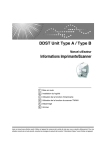
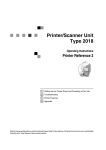

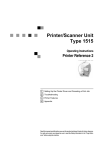
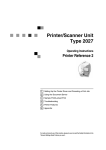
![e, em seguida, clique em [OK].](http://vs1.manualzilla.com/store/data/006041527_1-e60f27174a145f9678da70caa82fcb7d-150x150.png)
